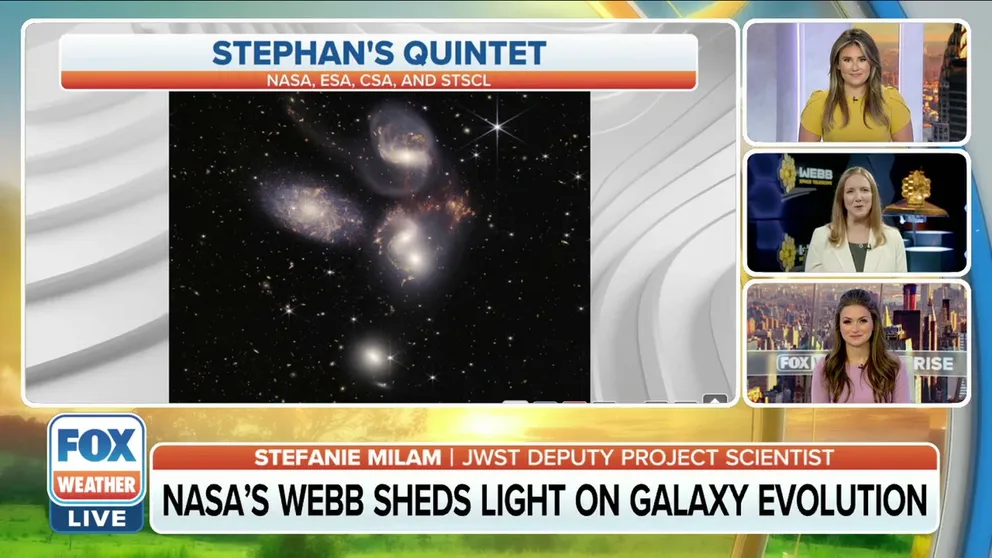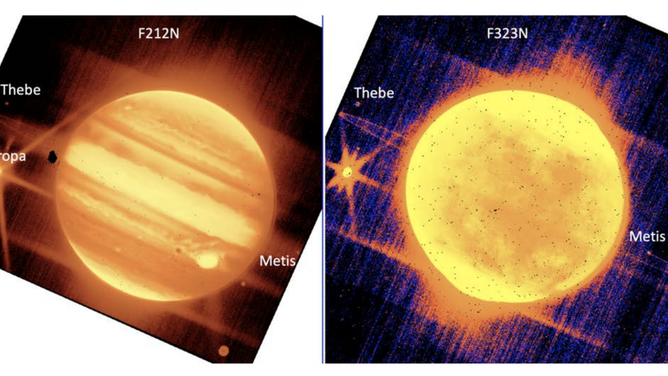James Webb Space Telescope observes weather light-years away, starting with a puffy hot exoplanet
JWST will soon observe a whole exoplanet system
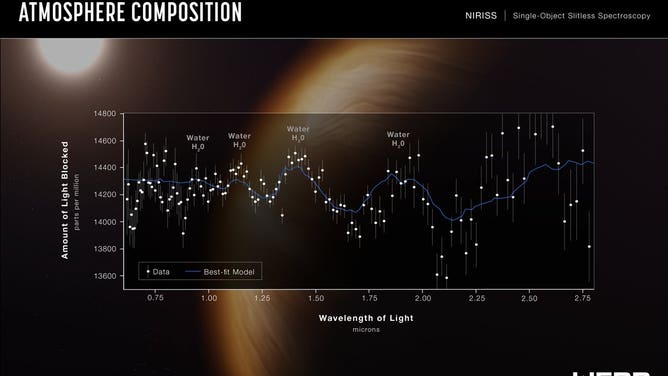
Canada’s instrument NIRISS on Webb reveals the distinct signature of water in the atmosphere of a hot, puffy gas giant exoplanet orbiting a distant Sun-like star. (Image: CSA/NASA/ESA)
NASA's James Webb Space Telescope is already sharing crucial clues about the climates and weather of planets outside our cosmic neighborhood known as exoplanets, and the $10 billion observatory is just getting started.
From the melt-your-face-off temperatures of Venus to the dust storms on Mars, planets in our solar system have unique climates and weather. However, Earth is the only planet with the proper temperatures to support life because it's the right distance from the sun, our solar system's star. Scientists now know other planet systems exist, and more than 5,000 exoplanets have been confirmed.
The James Webb Space Telescope began its first scientific observations this week after NASA, the European Space Agency and the Canadian Space Agency released a handful of test images and data the telescope took to show off its potential.
As part of those first images released, Webb studied the exoplanet called WASP-96b, a scorching gas giant world orbiting a sun-like star more than 1,000 light-years away. The Canadian Space Agency-built Near-Infrared Imager and Slitless Spectrograph (NIRISS) was used to capture water signatures, including the evidence of clouds and haze around the world.
Webb deputy project scientist for exoplanet science Knicole Colón describes WASP-96b as a giant gas planet like Jupiter. Its temperature is over 1,000 degrees, and it orbits incredibly close to its sun-like star.
The science behind the first images from the James Webb Space Telescope
Stefanie Milam, James Webb Space Telescope deputy project scientist, explains the science behind the first images from the James Webb Space Telescope.
"It's very big and fluffy with a thick atmosphere compared to Earth…it's about the same size, a little bit larger than Jupiter, but it's actually half the mass of Jupiter, Colón said. "What that means is that the core of the planet is very small and dense, and then there's a really thick layer of gas around it that makes it low density overall. So it's just a really puffy planet."
JAMES WEBB SPACE TELESCOPE IMAGES WOW BY SHOWING STAR NURSERY, GALAXIES IN A COSMIC DANCE
The spectrograph instrument collects light in infrared, which includes thousands of colors compared to what the human eye can see, allowing scientists to understand the chemical composition of things without ever directly touching them.
"What we do is we actually look at how much light is blocked at each of those colors by the planet's atmosphere," Colón said. "And when we do that, we can see differences depending on what color you're looking at. So we know essentially at what color water will block light."
Hubble Space Telescope observations did not detect clouds, so it was a bit of a surprise when Webb found them. However, Colón said this does not mean Hubble's data is wrong.
"Weather can change rapidly. And so it's the kind of thing where this could just be a one-off thing where we see clouds at this particular time, essentially," she said.
The observations of WASP-96b were taken over about six hours. With more time, the telescope could capture weather patterns and cloud movement.
"If we keep looking at it over and over again, we can come back and see how those features change, like those bumps up to indicate water absorption they might change in their amplitude," she explained. "And that could indicate the formation and dissipation of clouds that are like damping the water that we're seeing that could be like higher in altitude right then than where the water is in the atmosphere."
Colón explains the observatory can study exoplanets in two ways.
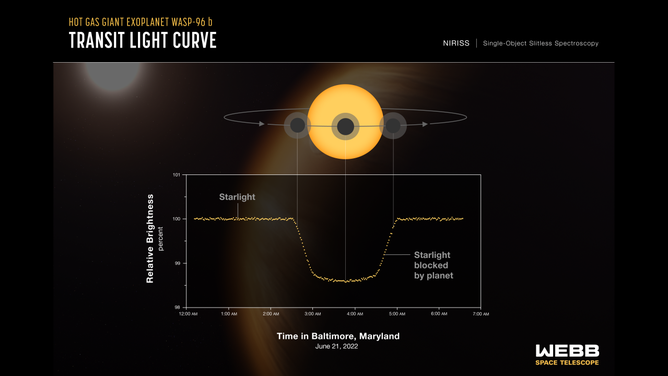
A light curve from Webb’s Near-Infrared Imager and Slitless Spectrograph (NIRISS) shows the change in brightness of light from the WASP-96 star system over time as the planet transits the star. (ILLUSTRATION: NASA, ESA, CSA, STScI)
The James Webb Space Telescope can measure the brightness of a star over time and see the dip in light as a planet passes in front, and also measure a planet's atmosphere using this method because the light from different colors of the rainbow can indicate different elements within the atmosphere.
The other way to study exoplanets is by blocking the light from a star to see faint dots around it, which are planets. The Webb exoplanet science team will look at exoplanets they already know exist and search for new worlds that may be undiscovered.
NASA also released photos and spectra data observations of Jupiter and some of its moons taken by the James Webb Space Telescope, demonstrating the observatory's ability to track solar system targets and produce images and spectra with unprecedented detail.
Webb's moon Europa is thought to have a global ocean under its icy crust. Vapor and icy particles are spewing from the world, and Webb could potentially study these subsurface volcanic eruptions.
SHE WASN'T ALLOWED TO STUDY ASTRONOMY -- THEN, SHE BECAME A NASA SCIENTIST
Next: A whole exoplanet system
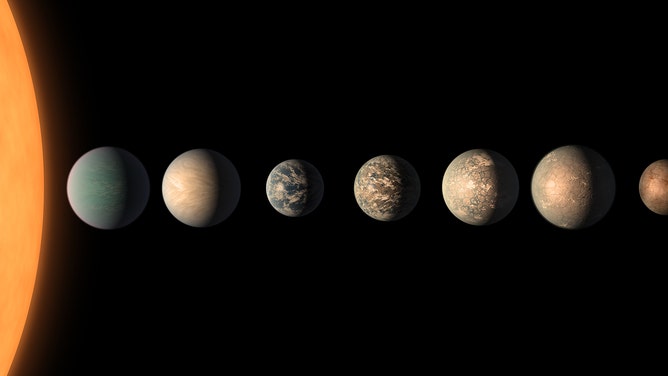
This artist's concept shows what the TRAPPIST-1 planetary system may look like, based on available data about the planets' diameters, masses and distances from the host star, as of February 2018. (Credit: NASA/JPL-Caltech)
JWST's next exoplanet target is a whole system known as TRAPPIST-1, looking for possibly habitable planets in the system 40 billion light-years away.
HOW THE TELESCOPE BECAME OUR WINDOW INTO THE UNIVERSE
Within TRAPPIST-1, there are seven planets orbiting much closer to their star than our planets orbit the sun. The TRAPPIST system star is also cooler and smaller than our sun. There is potential that some of these exoplanets have atmospheres similar to Earth. One of the most exciting things Colón hopes to learn is what these far-off solar systems can tell us about our own.
"We look at our solar system, and almost no two planets are alike in our system. And so, how common is that? What does that mean for the potential for habitability? Just because you're the size of Earth-like Venus doesn't mean you're going to be habitable and doesn't mean you're going to have weather like an atmosphere like Earth just because you're the size of Earth," she said.
Another weather question JWST could help answer is about some exoplanets that orbit closer to their stars and are presumed to be tidally locked, meaning there is a night side and day side of the planet, similar to the moon and Earth.
"What does that do to weather we're trying to find out because it's just like an extreme situation for these planets that are really close to their stars," Colón said. "They're just locked. And so what does that mean for understanding how anything happens?"
Webb's first year of science is already planned out, but now that the world can see what it is capable of, the Webb science team hopes the subsequent proposals using Webb will go even further.
"It's performing better than expected. Now that people will see real data, I think they'll start to think more outside the box because studying the weather on these distant planets is a really hard thing to do," Colón said.
Early observations show the James Webb Space Telescope is ready for those cosmic curveballs.
